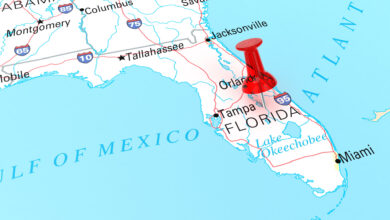C. Farris Bryant went from Ocala High School to the state’s top position

Perhaps the most significant politician to be raised in Ocala was Cecil Farris Bryant, who would serve as Florida’s 34th governor from 1961-65 and later serve as director of the Office of Emergency Planning in the Lyndon Johnson administration from 1966-67.
Born in Ocala in 1914, Bryant graduated from Ocala High School then earned his B.A. from the University of Florida before earning a law degree from Harvard University. After serving in the Navy during World War II, Bryant embarked on a political career that would take him to speaker of the Florida House of Representatives in 1953.
His victory in the 1960 gubernatorial election would come at a time of enormous transition in the United States and especially in Florida, which was the fastest growing state at that time while also dealing with the issue of racial segregation. A Democrat who was elected as a segregationist, Bryant was not of the obstructionist mold of others at the time such as Gov. George Wallace of Alabama. He never blocked a school entrance, but during the campaign, Bryant famously remarked that, “The less said about segregation the better. To talk about it merely incites people and doesn’t solve the problem.”
Although Bryant helped transform the state by increasing funding for highways and the expansion of the university system, all to help attract tourism, businesses and new residents, it is his less-than-tepid response to racial segregation that has tainted what was otherwise a glowing legacy. He supported segregation, but refused to do so at the expense of violence or school closures. When the Freedom Riders attempted to test the state’s segregation laws, Bryant worked closely with the state police to persuade restaurants to serve the demonstrators or close temporarily, thereby avoiding violence that had taken place in other Southern states.
During the contentious civil rights protests in St. Augustine in 1964, Bryant was slow initially to quell violence but later ordered the National Guard to protect black demonstrators and arrest white lawbreakers.
In those days, governors were limited to just one term, so when he left office he joined the Johnson administration as director of the OEP. In 1970, Bryant would run for a seat in the U.S. Senate, and with his high name recognition seemed a favorite to win, but Lawton Chiles pulled an upset victory in a primary run-off. That would be the last time Bryant would run for political office.
In returning to civilian life, Bryant moved to Jacksonville where he practiced law and headed the National Life Insurance Co.
His views on segregation reflected the era in which he grew up, but in the end, Bryant was instrumental in building Florida’s highways, including the turnpike, which was a major factor in attracting Walt Disney World. He pioneered bond financing to expand the university system and was instrumental in getting a constitutional amendment passed to fund the acquisition of state lands for preservation.
When he died in 2002, Bryant was especially proud of his legacy that helped pave the way for Florida’s role today as a major player in tourism and industry. Under Bryant’s leadership and promotion, the number of schools in the State University System doubled, Cape Canaveral expanded to five times its original size, airlifting of Cuban refugees was celebrated and reapportionment increased urban representation.
Despite the glowing parts of his legacy, Bryant held firm to his beliefs on segregation until the day he died. In an Orlando Sentinel interview in 2000, Bryant claimed equality among the races would come faster “by changing the minds of the white people, not by forcing them to do something by taking their property away from them.”






